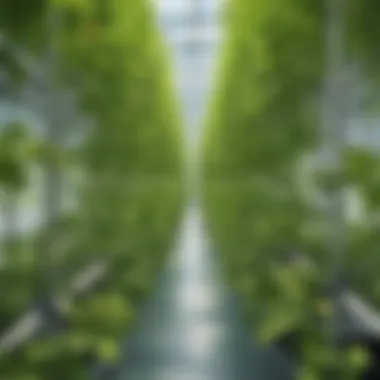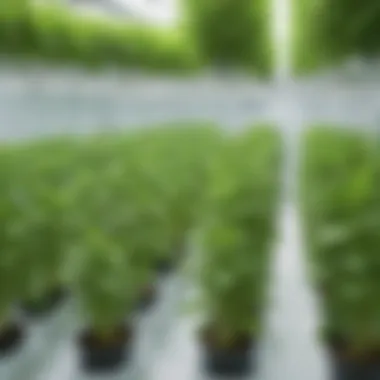Revolutionizing Plant Growth: Unleashing the Power of Hydroponic Techniques


Science Fun Facts
Hydroponic methods have been around for centuries, providing an innovative approach to plant growth that is sustainable and efficient. Did you know that the discovery of hydroponics dates back to the ancient Hanging Gardens of Babylon? This fascinating method allows plants to grow without soil, relying on nutrient-rich water solutions instead.
Discover the Wonders of Science
Exploring the principles of hydroponics unveils a world of scientific concepts related to plant biology and nutrient uptake. Educational videos and animations can visually illustrate how plants thrive in hydroponic systems. By understanding real-life applications of hydroponics, one can appreciate its significance in sustainable agriculture.
Science Experiment Showcase
Engage in a fun and educational experiment by setting up a simple hydroponic system at home! With step-by-step instructions and a materials list including containers, nutrient solutions, and growing medium, children can learn hands-on about plant growth without soil. Safety tips and precautions ensure a secure and enriching experimentation environment.
Hydroponic gardening is a cutting-edge technique that is reshaping the way we cultivate plants. This article delves deep into the realm of hydroponics, shedding light on its innovative approaches and sustainable practices. From introductory concepts to advanced methodologies, readers will gain an in-depth understanding of how hydroponic methods are transforming plant growth.
What is Hydroponics?
Definition and Concept
Hydroponics revolves around the practice of growing plants without soil, using nutrient-rich solutions to foster growth instead. This method emphasizes direct nourishment delivery to plant roots, enabling efficient absorption and optimized resource utilization. By eliminating the need for soil, hydroponics minimizes the risk of soil-borne diseases, offering a precise and controlled environment for plant development.
Historical Background
The origins of hydroponics can be traced back to ancient civilizations like the Babylonians and Aztecs, who employed similar techniques to grow crops in water. However, modern hydroponics as we know it today has evolved as a response to the need for sustainable agriculture practices in an increasingly urbanized world. Its historical progression reflects a shift towards resource-efficient and high-yield farming methods, making it a pivotal component of contemporary agricultural innovation.
Advantages of Hydroponic Gardening
Water Conservation
One of the primary benefits of hydroponic gardening is its superior water efficiency compared to traditional soil-based farming. By recirculating nutrient solutions within a closed system, hydroponics drastically reduces water wastage, making it an environmentally conscious choice for sustainable agriculture. This method's precise watering mechanisms also prevent water runoff, conserving this precious resource for optimal plant nourishment.
Optimal Nutrient Absorption


Hydroponic systems offer plants direct access to essential nutrients, ensuring rapid and efficient absorption. By delivering nutrients directly to the root system in the absence of soil barriers, plants can uptake nutrients more effectively, promoting robust growth and healthy development. This targeted nutrient delivery enhances plant vitality and minimizes nutrient loss, optimizing overall plant health.
Types of Hydroponic Systems
Nutrient Film Technique (NFT)
The Nutrient Film Technique (NFT) is a hydroponic system where a thin film of nutrient solution flows over plant roots, providing a constant supply of nutrients. This continuous flow system ensures consistent nourishment uptake, fostering rapid growth and enhanced nutrient absorption efficiency. NFT systems are favored for their resource efficiency and suitability for high-density plant cultivation, making them ideal for commercial hydroponic operations.
Deep Water Culture (DWC)
Deep Water Culture (DWC) systems immerse plant roots directly into a nutrient solution, promoting direct nutrient uptake and oxygenation. By submerging roots in aerated water, DWC systems enhance oxygen availability to roots, stimulating vigorous growth while maintaining nutrient balance. This method's simplicity and effectiveness make it a popular choice for beginners and seasoned hydroponic enthusiasts alike.
Ebb and Flow System
The Ebb and Flow system, also known as the Flood and Drain system, alternates between flooding plant trays with nutrient solution and draining them. This cyclical watering mechanism ensures roots receive adequate nutrients and oxygen while preventing waterlogging. Ebb and Flow systems offer flexibility in nutrient delivery and irrigation intervals, allowing for customized growth environments tailored to specific plant requirements.
Setting Up a Hydroponic System
Essential Components
Reservoir
The reservoir serves as the foundational component of a hydroponic system, holding the nutrient solution essential for providing plants with the necessary elements for growth. In this article, the reservoir's prominence stems from its critical role in maintaining a consistent supply of nutrients to the plants throughout their growth cycle. Its capacity, material, and placement are pivotal factors that influence the overall efficiency and functionality of the hydroponic system, making it a popular and indispensable choice for hydroponic practitioners seeking precise control over nutrient delivery.
Growing Medium
The growing medium is a vital element in hydroponic systems as it supports plant roots and facilitates nutrient absorption. In the context of this article, the growing medium's paramount importance lies in its ability to mimic soil while promoting optimal root health and nutrient uptake. Its characteristics, such as water retention and aeration properties, make it a favored choice among hydroponic enthusiasts looking to maximize plant growth efficiently.
Nutrient Solution
The nutrient solution plays a crucial role in providing plants with essential minerals necessary for their healthy development. Within the scope of this article, the nutrient solution stands out for its customizability and precise formulation, tailored to meet specific plant requirements. Its unique feature lies in delivering a balanced blend of nutrients directly to the plant roots, offering advantages in nutrient absorption and overall plant health optimization.


Environmental Factors
Lighting
Efficient and appropriate lighting is key to photosynthesis and overall plant growth in hydroponic systems. In the context of this article, lighting is pivotal for simulating natural sunlight, promoting healthy plant development. Its unique feature of customizable spectrum and intensity provides hydroponic practitioners with the ability to tailor lighting conditions to meet the specific needs of different plant varieties, ensuring optimal growth outcomes.
Temperature and Humidity
Maintaining optimal temperature and humidity levels is essential for creating a conducive growing environment in hydroponic systems. In this article, the focus on temperature and humidity underscores their role in regulating plant metabolic processes and preventing stress-induced growth stunting. Their unique features include precise control mechanisms and monitoring systems that enable hydroponic enthusiasts to fine-tune environmental conditions for maximum plant vitality.
Air Circulation
Proper air circulation is crucial for ensuring adequate oxygen levels around the roots and facilitating gas exchange in hydroponic systems. Within the scope of this article, air circulation is highlighted for its role in preventing stagnant air pockets and mold formation, promoting overall plant vigor. Its unique feature lies in enhancing nutrient absorption and root health, offering advantages in mitigating risks associated with poor air quality in hydroponic environments.
Maintenance Tips
Monitoring pH Levels
Regular monitoring and adjustment of p H levels are essential for maintaining nutrient availability and optimal plant growth in hydroponic systems. In this article, the emphasis on monitoring pH levels underscores its significance in preventing nutrient deficiencies and imbalances. The unique feature of pH monitoring tools allows hydroponic practitioners to precisely calibrate nutrient solutions, ensuring plants receive the correct pH levels for robust growth.
Preventing Algae Growth
Effective management of algae growth is critical for preserving water quality and preventing nutrient competition in hydroponic systems. Within the context of this article, the focus on algae growth prevention highlights its role in maintaining a clean and nutrient-rich environment for plant cultivation. The unique feature of algae-resistant materials and UV sterilization methods offers advantages in minimizing algae proliferation and safeguarding plant health in hydroponic setups.
Plant Nutrition in Hydroponics
In the realm of hydroponics, the nutrition of plants plays a pivotal role in their growth and development. Understanding the intricacies of plant nutrition is essential for maximizing yield and ensuring healthy crops. Within the context of this article, delving into the specifics of plant nutrition in hydroponics is integral to comprehending the holistic approach of this innovative cultivation method. By focusing on elements such as macro and micro nutrients, as well as the regulation of p H levels, readers will gain valuable insights into optimizing plant health and overall crop production.
Understanding Nutrient Requirements
Macro and Micro Nutrients


Within the domain of plant nutrition in hydroponics, the distinction between macro and micro nutrients is crucial. Macro nutrients such as nitrogen, phosphorus, and potassium are essential for the overall growth and vitality of plants. On the other hand, micro nutrients like iron, manganese, and zinc play a more specialized role in supporting various metabolic functions within the plant. The balance of these nutrients is imperative for ensuring that plants thrive in a hydroponic system, making them a popular choice due to their precise and easily adjustable nature.
pH Regulation
Another key aspect of plant nutrition in hydroponics is the regulation of p H levels in the nutrient solution. Maintaining the optimum pH range is vital for enabling plants to absorb nutrients effectively. pH regulation ensures that essential elements are readily available to plants without the risk of nutrient deficiencies or toxicities. While managing pH levels adds a layer of complexity to hydroponic cultivation, it ultimately leads to healthier plants and improved crop yields.
Balanced Nutrient Formulas
Commercial vs. Homemade Solutions
In the realm of balanced nutrient formulas for hydroponic systems, the choice between commercial and homemade solutions presents a significant consideration. Commercial solutions offer convenience and precise formulations tailored to specific plant requirements. Conversely, homemade solutions provide a more customizable approach, allowing growers to adjust nutrient mixes based on plant responses and environmental factors. Both options have their advantages and disadvantages, with commercial solutions offering consistency and ease of use, while homemade mixes provide flexibility and cost-effectiveness.
Customizing Nutrient Mixes
Customizing nutrient mixes in hydroponics enables growers to fine-tune plant nutrition according to their unique needs. This personalized approach allows for adjustments based on plant growth stages, environmental conditions, and crop varieties. By customizing nutrient mixes, growers can address specific deficiencies, optimize nutrient uptake, and enhance overall plant health. While this level of customization requires careful monitoring and knowledge of plant requirements, it empowers growers to maximize growth potential and achieve superior yields.
Optimizing Growth and Yield
When looking to revolutionize plant growth through hydroponic methods, optimizing growth and yield stands out as a crucial aspect. By focusing on maximizing plant health, which involves utilizing advanced techniques to ensure plants thrive in a controlled environment, growers can achieve higher yields and healthier plants. This section delves into the various elements that contribute to optimized growth and yield, ranging from pruning and training techniques to effective pest and disease management.
Maximizing Plant Health
Pruning and Training Techniques
Pruning and training techniques play a vital role in maximizing plant health within the realm of hydroponic gardening. These techniques involve strategically trimming excess foliage and shaping plants to enhance airflow and light exposure, ultimately leading to improved growth and productivity. The key characteristic of pruning and training lies in its ability to promote optimal plant development, ensuring that resources are efficiently utilized for maximum yield. While these techniques require precision and regular maintenance, their benefits in promoting plant vitality and simplifying harvesting make them a popular choice among hydroponic growers.
Pest and Disease Management
Effective pest and disease management is essential for maintaining plant health and productivity in a hydroponic system. Through proactive measures such as employing biological controls and maintaining proper hygiene practices, growers can prevent infestations and diseases that could hinder plant growth. The key characteristic of pest and disease management lies in its ability to safeguard plants against various threats, ensuring a thriving growing environment. While the need for constant vigilance and monitoring is a downside, the advantages of preventing crop damage and preserving plant health outweigh the challenges associated with this aspect of hydroponic cultivation.
Harvesting and Replanting
Timing Harvests
Timely harvesting is a critical aspect of optimizing growth and yield in hydroponic gardening. By harvesting plants at the peak of their ripeness, growers can maximize flavor and nutritional content while promoting continuous growth cycles. The key characteristic of timing harvests lies in its role in supporting a consistent supply of fresh produce while minimizing wastage. While the precise timing of harvests requires careful observation and planning, the benefits of ensuring peak quality and flavor make this practice indispensable in hydroponic cultivation.
Preparation for Replanting
Preparing for replanting is a fundamental step in optimizing growth and yield within a hydroponic system. This process involves cleaning and disinfecting grow beds, replenishing nutrient solutions, and ensuring optimal environmental conditions for new plantings. The key characteristic of preparation for replanting lies in its capacity to create a nurturing environment for incoming crops, setting the stage for successful growth and high yields. While the time and effort required for preparation may seem labor-intensive, the advantages of ensuring plant health and productivity in subsequent growth cycles make it a worthwhile investment in the long run.







